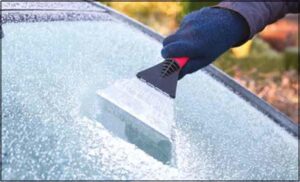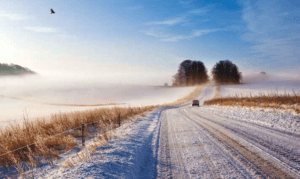The roads can be dangerous in winter when there’s snow, ice or sleet. Stopping distances can be 10 times longer when it’s icy. Gentle manoeuvres and slow speeds are the key to safe driving in ice and snow.
Safe Vehicle
Give yourself more time to de-ice your vehicle and clear snow from the whole vehicle. Snow on a vehicle roof can flick off backwards as you drive, hitting the vehicles behind you. It can also slump forward over the windscreen during braking. This is especially likely when the underside has begun to melt as the vehicle’s cabin warms up.
Check your vehicle over regularly during winter conditions. Check fuel levels – have at least a quarter of a tank of fuel available in case of unexpected delays. Use a suitable additive in your screenwash to reduce the chance of it freezing. Make sure all car lights are working and the lenses are clean. If the roads are really mucky, you might have to clean your lights after every trip. Keep number plates clean, to avoid fines. Check your engine has antifreeze. Antifreeze only costs a few pounds, but a frozen and cracked engine costs hundreds to repair. Don’t leave your wipers on auto when you park up if there’s a risk of frost. If the blades freeze to the screen, you could damage the blades or wiper motor when you turn the ignition on. Air-con demists the screen faster and reduces condensation.
Car batteries rarely last longer than 5 years. There are extra demands on them in the winter thanks to lights, heating and wipers. Turn off electrical loads like lights, heated rear window and wipers beforestarting the engine. Use the starter in short 5-second bursts and if the engine doesn’t start quickly, wait 30 seconds between attempts.
Give yourself more time to de-ice your vehicle and clear snow from the whole vehicle.
Safe Route
Plan routes so you use major roads where possible. These are more likely to be cleared and gritted. Much of our work is accessed via smaller rural roads so consider local conditions before setting out and keep them under review enroute.
If you are struggling for traction pull away in second gear, easing your foot off the clutch gently to avoid wheel- spin. If you drive an automatic, check the handbook – some have a winter mode or recommend selecting ‘2’ in slippery conditions. If your vehicle has regenerative braking (hybrid or electric) check the handbook for appropriate settings in ice and snow.
If you get stuck, straighten the steering and clear the snow from the wheels. Put a sack or old rug in front of the driving wheels to give the tyres some grip. You must use headlights when visibility is reduced. If you use fog lights, remember to switch them off when visibility improves so they don’t dazzle other drivers or obscure your brake lights.
Driving uphill – leave plenty of room between other cars or wait until it’s clear so you don’t have to stop part way up. Keep a constant speed and try to avoid having to change gear on the hill.
Driving downhill – slow down before the hill, use a low gear and try to avoid braking. Leave as much room as you can between you and the car in front.
Safe Driver
Like the Scout Association motto says: ‘Be Prepared’.
There are a few essentials you should keep in your vehicle when you’re driving in winter, these will help you deal with ice, snow and dark winter nights:
- Ice scraper
- De-icer
- Torch
- Spare torch batteries.
You should also keep your phone charged.
No matter how safely you drive, there’s still a chance you could get stuck somewhere in poor weather. Pack a winter emergency kit, just in case. That way you’ll be prepared for a long wait in the cold. Here’s what to include:
- Warm clothes, waterproofs and high-vis jackets.
- Sturdy footwear.
- Hot drinks and snacks.
- Shovel.
- Jump leads.
- Warning triangles.





